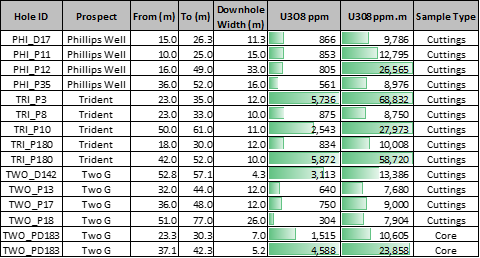Overview
Location
Queensland, Australia
Ownership
100% IsoEnergy
Mineralization
Volcanogenic Caldera-related
Primary Minerals
Uranium
Stage
Advanced Exploration
Highlights
- Known uranium prospects and untested exploration upside across all three Projects.
- Both West Newcastle Range and Teddy Mountain have potential for the discovery of high grade, near surface Uranium mineralization with historic results including:
- 12 metres grading 0.57% U3O8 from 23 metres and 10 metres grading 0.59% U3O8 from 42 metres at West Newcastle Range
- 10 m at 0.63% U3O8 including 2 m @ 1.8% U3O8 from 12 m at Teddy Mountain.
- Ardmore East covers exploration stage prospects with uranium and vanadium mineralization, and anomalous REE signature.
The West Newcastle Range project is an advanced stage exploration project located five kilometres northeast of Georgetown and approximately 40 kilometres southeast of the Georgetown uranium project. The West Newcastle Range exploration licence application consists of 78 sub-blocks covering a total area of 25,500 hectares (255 km2). Extensive uranium exploration has been carried out between 1973 and 1983, including airborne and ground based radiometrics, VLF-EM, rockchip and stream geochemical sampling, geological mapping and over 36,000 metres drilled over various uranium prospects. In today’s dollar terms, this level of inground exploration is estimated to cost in excess of CAD$20 million.
The West Newcastle Range Project comprises five main uranium prospects. The Two Gee, Gecko, Trident, and Sybnac Prospects form an approximately 5 km long structurally controlled trend on the northeast edge of an interpreted caldera margin. The Quartz Blow prospect is part of an additional 5 km long northeast oriented trend. Multiple other prospects occur on the project, with uranium intersected in drilling and encountered in surface samples.
Significant historic drill intersections are shown in Table 1 below, including 12.0 m @ 5,736 ppm U3O8 from 23.0 m and 10.0 m @ 5,872 ppm U3O8 from 42.0 m Trident, and 5.2 m @ 4,588 ppm U3O8 from 37.1 m.

Untested outcropping mineralization is evident in the historic geophysical and geochemical datasets and the caldera volcano-sedimentary infill sequence is expected to be a prime target for large-scale, high-grade concealed mineralization as observed elsewhere in the world. World-class examples of caldera related volcanic Uranium deposits include the Streltsovsk district in Russia comprising >600 Mlbs U3O81 and the Dornod district in Mongolia >100 Mlbs U3O82. Other examples include the Xiangshan district (China), the Macusani district (Peru), the Kurišková and Novoveská Huta deposits (Slovakia) and the deposits of the McDermitt caldera (USA). Often the high-grade uranium mineralization within caldera systems is concealed and manifests a lower grade structurally hosted mineralization at surface.

